As the Russia-Ukraine war continues, the promise of a ceasefire often brings a mix of hope and skepticism. Recently, Vladimir Putin announced a ceasefire, but Ukrainian forces on the front lines immediately expressed their doubts. This article delves into the alleged ceasefire violations and the ongoing distrust between the two nations.
The situation is critical, with potential implications for regional stability and international relations. Understanding the nuances of ceasefire agreements and violations is essential for anyone following the conflict.
We will examine the specific violations reported by Ukrainian officials, the strategic implications of these actions, and the broader context of mistrust that undermines any attempts at de-escalation.
Bad Weather and Initial Skepticism
On the front lines of eastern Ukraine, the weather conditions were far from ideal as the supposed ceasefire approached. Heavy clouds and persistent rain created an environment where military activity was expected to be minimal. However, the soldiers at the National Guard monitoring center harbored deep skepticism regarding Vladimir Putin’s intentions.
As the designated hour of midnight approached on Wednesday, these Ukrainian forces, tasked with monitoring the front lines, expressed a complete lack of faith in the ceasefire declared by the Russian President.
According to Kir, a drone special unit commander, his view was aligned with that of Ukrainian President Volodymyr Zelensky, who has continuously called for an immediate 30-day cessation of hostilities.
Continued Attacks Across the Front Line
Almost a full day into the declared Russian ceasefire, Ukrainian officials reported persistent attacks across the entire front line. These reports indicated a clear violation of the agreed-upon cessation of hostilities, intensifying the already high tensions.
Foreign Minister Andrii Sybiha stated that Ukrainian troop positions had been subjected to more than 500 attacks throughout the day. Furthermore, at least ten strikes were carried out using guided aerial bombs. One such strike tragically resulted in the death of a 55-year-old woman and injuries to her son in the northern Sumy region.
In the southern Kherson region, officials reported that a 35-year-old woman was killed in a drone strike, adding to the growing list of casualties and further underscoring the alleged ceasefire violations.
Monitoring Russian Activity
Operating from an undisclosed location, Kir and his team maintained constant vigilance, monitoring for any signs of Russian aggression. The surveillance center was equipped with numerous monitors displaying live feeds from over 100 surveillance drones deployed across nearly half of the front line.
Approximately 60 cameras were specifically focused on the Donetsk region. According to Kir, only Mavic drones were in operation due to the adverse weather conditions. Under normal circumstances, the surveillance would involve even more feeds, providing a more comprehensive view of the area.
Shortly after midnight, the team reported several instances of Russian activity, including artillery fire near Pokrovsk, a Grad rocket fired near Toretsk, and further artillery fire near Sloviansk. Although the frequency of attacks was relatively low, Kir noted an unusually high level of surveillance drone activity by Russian forces, raising concerns about potential strategic moves.
Doubts About Putin’s Intentions
Kir expressed strong skepticism about Putin’s real intentions, recalling a previous snap ceasefire over Easter. During that period, Russia allegedly used the opportunity to resupply its positions and redeploy troops, resulting in strategic gains for the Russian forces.
According to Kir, these actions allowed Russia to successfully strike after Easter, leading to the loss of some Ukrainian positions. This history of alleged deception has fueled a deep mistrust of any ceasefire announcements made by the Russian leader.
Kir anticipates that the latest ceasefire will also be exploited for further infantry movements, undermining any genuine attempt at de-escalation and prolonging the conflict.
Evidence of Troop and Hardware Movements
The National Guardsmen presented additional evidence suggesting that the Kremlin has no real interest in achieving peace. Surveillance feeds have consistently shown Russia moving significant numbers of troops and military hardware into positions just a few dozen kilometers from the front lines.
The team shared a video, filmed just days prior, depicting an extensive network of dugouts, tarpaulins, and vehicles, carefully spaced along a seemingly endless tree line. This build-up of military resources close to the front indicates preparations for further offensive operations, rather than a genuine commitment to a ceasefire.
These observations reinforce the belief that any declared ceasefire is merely a strategic ploy to regroup and strengthen Russian forces for future attacks, rather than a sincere effort to end the conflict.
Historical Parallels and Mistrust
Kir drew a parallel to Russia’s annexation of Crimea in 2014, reminding that Moscow initially denied any involvement before moving swiftly to annex the territory illegally. This historical context underscores the deep-seated mistrust between Ukraine and Russia.
He stated, “They started with a lie. And they’re still lying,” highlighting the perception that Russia’s actions are consistently based on deception and misinformation. This sentiment reflects a broader skepticism towards any agreements or declarations made by the Russian government.
The historical context of broken promises and deceptive tactics contributes to the Ukrainian forces’ lack of faith in the current ceasefire, viewing it as another potential manipulation rather than a genuine effort to achieve peace.
Conclusion
The alleged ceasefire violations and the deep-rooted mistrust between Ukraine and Russia highlight the complexities of the ongoing conflict. Despite the declared ceasefire, Ukrainian forces report continued attacks and troop movements, raising serious doubts about Russia’s true intentions.
The situation remains highly volatile, with potential implications for regional stability and international relations. The historical context of broken promises and deceptive tactics further undermines any attempts at de-escalation.
As the conflict continues, the international community must remain vigilant and continue to seek avenues for a genuine and lasting resolution, based on mutual trust and respect for international law.

Leave a Reply